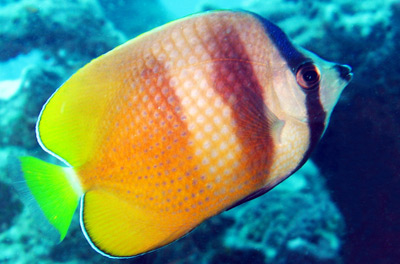The word “beginner” and “butterflyfish” aren’t often paired together, as so many of the butterflyfishes seem to present some manner of husbandry challenge, often related to diet. Still, certain butterflies have a well-deserved reputation for hardiness and general ease of care. Among them is Chaetodon kleinii, commonly called Klein’s butterflyfish but also known by a variety of other epithets, such as the sunburst butterflyfish, orange butterflyfish, brown butterflyfish, blacklip butterflyfish, Corallicola butterflyfish, and probably a few others I’m not aware of.
Physical traits
Reaching between 5 and 6 inches in total length, C. kleinii exhibits the laterally compressed body typical of butterflies and is mostly golden-yellow on the posterior half of the body. From about mid-body forward, the base coloration becomes more creamy white, with a vertical dusky-brown band occurring just behind the operculum (gill cover), a vertical black band passing through the eye, and black lips.
Feeding
According to Fishbase, in nature, this Indo-Pacific butterfly feeds “mainly on soft coral polyps (mainly on Sarcophyton tracheliophorum and Litophyton viridis), algae, and zooplankton.” Specimens kept in aquariums should be offered, and will typically accept, a variety of readily available foods, such as frozen mysids, chopped fresh seafoods, and commercial formulations that satisfy their omnivorous palate. Also, be sure to provide multiple smaller feedings per day rather than one or two larger meals.
Housing
Though just a medium-sized fish, C. kleinii benefits from a good combination of open swimming space and rockwork for concealment. So, a good-sized tank is recommended. I wouldn’t go any smaller than 75-gallons for this fish, and a larger tank would be even better.
Compatibility
C. kleinii is a generally peaceful species that will coexist nicely with most other peaceful to moderately assertive species. It can also be kept in conspecific (same-species) groups provided all of the specimens are introduced to the tank at the same time. Keep in mind, however, that larger housing will be necessary if you plan to keep a group of these butterflies.
Considering its natural tendency to feed on certain coral polyps, C. kleinii cannot be considered reliably reef safe, so a fish-only or FOWLR (fish only with live rock) system is preferable.



